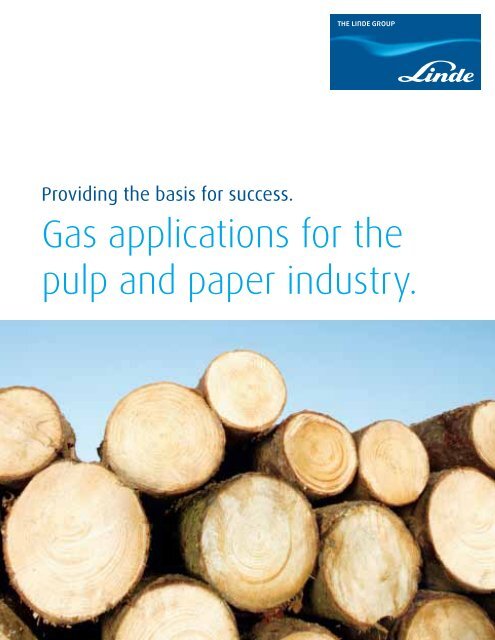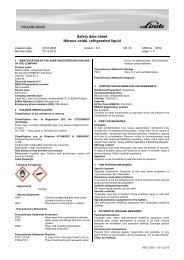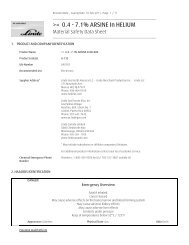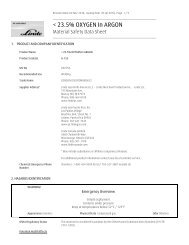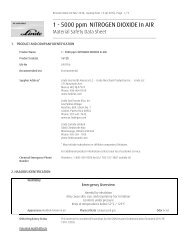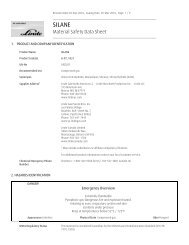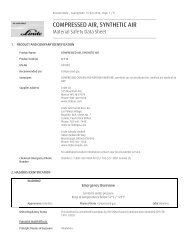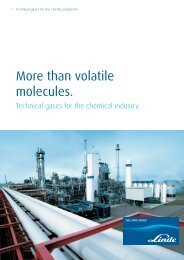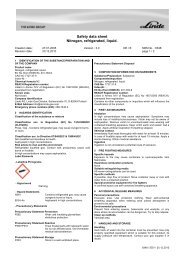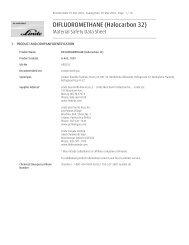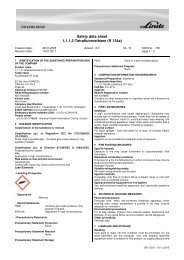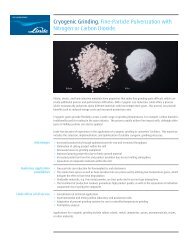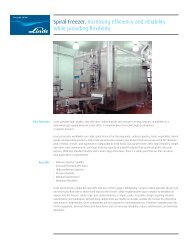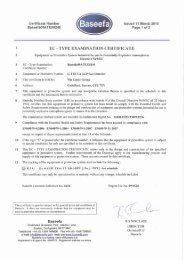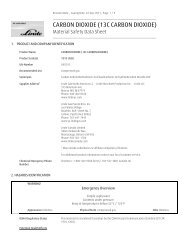Gas applications for the pulp and paper industry. - Linde North ...
Gas applications for the pulp and paper industry. - Linde North ...
Gas applications for the pulp and paper industry. - Linde North ...
You also want an ePaper? Increase the reach of your titles
YUMPU automatically turns print PDFs into web optimized ePapers that Google loves.
Providing <strong>the</strong> basis <strong>for</strong> success.<br />
<strong>Gas</strong> <strong>applications</strong> <strong>for</strong> <strong>the</strong><br />
<strong>pulp</strong> <strong>and</strong> <strong>paper</strong> <strong>industry</strong>.
02 Pulp <strong>and</strong> <strong>paper</strong> <strong>industry</strong>
Pulp <strong>and</strong> <strong>paper</strong> <strong>industry</strong><br />
03<br />
Enhancing productivity <strong>and</strong> per<strong>for</strong>mance.<br />
<strong>Gas</strong> <strong>applications</strong> <strong>and</strong> know-how from <strong>Linde</strong> <strong>Gas</strong>.<br />
<strong>Linde</strong> <strong>Gas</strong> supports 1.5 million customers in 50 countries, providing<br />
industrial <strong>and</strong> medical gases, application know-how, extensive services,<br />
<strong>and</strong> equipment to help make <strong>the</strong>ir operations more profitable, more<br />
efficient, <strong>and</strong> more environmentally sustainable.<br />
For <strong>the</strong> <strong>pulp</strong> <strong>and</strong> <strong>paper</strong> <strong>industry</strong>, technologies from <strong>Linde</strong> <strong>Gas</strong> provide<br />
modern, environmentally friendly manufacturing processes that enhance<br />
productivity <strong>and</strong> per<strong>for</strong>mance. <strong>Linde</strong> <strong>Gas</strong> has a wealth of knowledge <strong>and</strong><br />
experience concerning gas-based solutions <strong>and</strong> unique technologies<br />
<strong>for</strong> <strong>paper</strong> production, <strong>pulp</strong> production, <strong>and</strong> chemical recovery. Experts<br />
from <strong>Linde</strong> <strong>Gas</strong> work closely toge<strong>the</strong>r with customers in research <strong>and</strong><br />
development as well as in production <strong>and</strong> operational management,<br />
in order to achieve tailor-made solutions that improve <strong>the</strong> overall mill<br />
economy while also reducing environmental impacts.<br />
Each mill <strong>and</strong> each process calls <strong>for</strong> a special solution. When it comes<br />
to developing practical <strong>and</strong> profitable gas <strong>applications</strong> <strong>for</strong> <strong>the</strong> <strong>pulp</strong> <strong>and</strong><br />
<strong>paper</strong> <strong>industry</strong>, nothing can replace local presence at mill sites <strong>and</strong><br />
h<strong>and</strong>s-on activity.
04 Pulp <strong>and</strong> <strong>paper</strong> <strong>industry</strong>
Pulp <strong>and</strong> <strong>paper</strong> <strong>industry</strong><br />
05<br />
Adjust your process to your dem<strong>and</strong>s – <strong>and</strong><br />
keep it rolling. Using gases in <strong>paper</strong> mills.<br />
Carbon dioxide (CO 2 ) is widely used in <strong>the</strong> <strong>paper</strong> <strong>industry</strong> today. It is used<br />
in <strong>paper</strong> machines to adjust <strong>and</strong> stabilize pH, to buffer <strong>the</strong> <strong>paper</strong>making<br />
system, to decrease calcium levels, or to increase dewatering, <strong>for</strong><br />
instance. Today, <strong>Linde</strong> <strong>Gas</strong> has installations at various stages between <strong>the</strong><br />
stock preparation <strong>and</strong> <strong>the</strong> headbox <strong>for</strong> around 40 <strong>paper</strong> machines, running<br />
with chemical <strong>pulp</strong>s, mechanical <strong>pulp</strong>s, <strong>and</strong> recycled <strong>paper</strong>. CO 2 -based<br />
<strong>applications</strong> are useful where conditions in <strong>the</strong> stock preparation <strong>and</strong><br />
short circulation processes need to be stable.<br />
Regulating <strong>and</strong> stabilizing pH<br />
Over <strong>the</strong> last few years, more <strong>and</strong> more mills have started to use CO 2 , or a<br />
combination of CO 2 <strong>and</strong> caustic soda (NaOH) known as ADALKA Process<br />
Stabilizer, to regulate <strong>and</strong> stabilize pH. ADALKA also enhances <strong>the</strong><br />
alkalinity or buffering capacity of <strong>the</strong> process, as well as stabilizing <strong>the</strong><br />
wetend chemistry <strong>and</strong> unit operations such as beating <strong>and</strong> mixing. The<br />
increased buffering capacity also facilitates <strong>the</strong> optimization of chemical<br />
additions. The resulting sodium bicarbonate-based solution (NaHCO 3 ) is<br />
made on site from carbon dioxide <strong>and</strong> caustic soda in an alkalinity control<br />
unit reactor (ACU) from <strong>Linde</strong> <strong>Gas</strong>. Alkalinity <strong>and</strong> pH can be adjusted<br />
independently according to <strong>the</strong> process requirements. The buffer solution<br />
can <strong>the</strong>n be added to <strong>the</strong> process to control pH <strong>and</strong> increase alkalinity at<br />
critical points.<br />
Reducing CaCO 3 dissolution<br />
Calcium carbonate (CaCO 3 ) is present in many <strong>paper</strong>making systems today.<br />
Conditions in <strong>paper</strong> machines are often such that CaCO 3 starts to dissolve,<br />
leading to runnability problems, problems with precipitation <strong>and</strong> deposits,<br />
<strong>and</strong> higher consumption of many chemicals. Carbon dioxide or bicarbonate<br />
can be added to <strong>the</strong> process to reduce <strong>the</strong> dissolution of CaCO 3 , cutting<br />
calcium levels in <strong>the</strong> <strong>paper</strong>making system by as much as 50 %.<br />
CaCO 3 -related problems are particularly common when CaCO 3 is introduced<br />
as a filler in <strong>the</strong> production of <strong>paper</strong> qualities containing mechanical <strong>pulp</strong>,<br />
such as newsprint <strong>and</strong> supercalendered <strong>paper</strong>. To solve such problems,<br />
<strong>Linde</strong> <strong>Gas</strong> has designed an application known as GRAFICO Calcium<br />
Carbonate Saver, which can be used to stabilize processes where local pH<br />
variations, bacteria or slightly acidic conditions would o<strong>the</strong>rwise increase<br />
<strong>the</strong> dissolution of CaCO 3 . This application is already used in various ways<br />
in many mills around <strong>the</strong> world.<br />
Recycled <strong>paper</strong> also contains CaCO 3 . Our carbon dioxide application<br />
CODIP Process Improver has been developed primarily <strong>for</strong> newsprint<br />
production, where de-inked <strong>pulp</strong> is <strong>the</strong> main raw material. CODIP is<br />
presently in use at a number of large <strong>paper</strong> mills. Benefits include lower<br />
calcium levels, increased <strong>paper</strong> machine runnability, <strong>and</strong> stabilized pH<br />
profiles.
06 Pulp <strong>and</strong> <strong>paper</strong> <strong>industry</strong><br />
Environmentally friendly, economically<br />
beneficial. Using gases in <strong>the</strong> fiber line.<br />
FThe driving <strong>for</strong>ce behind <strong>the</strong> introduction of gas <strong>applications</strong> to <strong>the</strong> fiber<br />
line has been <strong>the</strong> urgent need to reduce environmental impacts. New gas<br />
<strong>applications</strong> also aim to reduce <strong>pulp</strong> production costs <strong>and</strong> improve quality,<br />
while low capital investment solutions are also clearly desirable. <strong>Linde</strong><br />
<strong>Gas</strong> is one of <strong>the</strong> main gas suppliers <strong>for</strong> <strong>the</strong> following <strong>applications</strong>:<br />
Oxygen delignification<br />
Oxygen delignification is an integral part of any modern fiber line<br />
producing bleached kraft <strong>pulp</strong>. Environmental considerations were<br />
originally <strong>the</strong> main factor behind <strong>the</strong> introduction of this process,<br />
as effluent loads from bleaching plants could be cut by 50 %. O<strong>the</strong>r<br />
advantages of oxygen delignification include decreased contents of shives<br />
<strong>and</strong> extractives as well as a reduced need <strong>for</strong> bleaching chemicals. Yields<br />
of cellulose <strong>and</strong> hemicelluloses are increased, as oxygen delignification is<br />
more selective than kraft cooking in terms of lignin removal. Capacity also<br />
increases in <strong>the</strong> digester <strong>and</strong> recovery boiler, two common bottlenecks<br />
in a mill. With <strong>the</strong> recent development of a two-stage process, oxygen<br />
delignification can take care of an even larger share of <strong>the</strong> delignification<br />
work in a <strong>pulp</strong> mill.
Pulp <strong>and</strong> <strong>paper</strong> <strong>industry</strong><br />
07<br />
Extraction <strong>and</strong> bleaching processes<br />
Alkaline extraction stages are conventionally rein<strong>for</strong>ced with an oxidative<br />
chemical – which may be oxygen alone or oxygen in combination with<br />
hydrogen peroxide. The idea here is to take advantage of <strong>the</strong> <strong>pulp</strong><br />
retention time during <strong>the</strong> hot alkaline stage, in order to achieve fur<strong>the</strong>r<br />
lignin breakdown while <strong>the</strong> lignin – which has already been fragmentized<br />
in <strong>the</strong> previous bleaching stage – is being removed from <strong>the</strong> fiber.<br />
Pressurized peroxide bleaching stages conducted at high temperatures<br />
can also benefit from <strong>the</strong> addition of oxygen, as <strong>the</strong> properties of <strong>the</strong> two<br />
oxidative chemicals are not identical.<br />
sequences. Ozone processes are highly cost-efficient, especially<br />
where new fiber lines are being set up.<br />
CO 2 <strong>pulp</strong>-washing<br />
Our CO 2 <strong>pulp</strong>-washing technology is in use in more than 30 fiber lines,<br />
including both bleached <strong>and</strong> unbleached lines. It is typically applied in<br />
mills’ existing washing systems, with benefits including better runnability,<br />
reduced steam consumption, lower wash water volumes, reduced usage<br />
of defoamer agents <strong>and</strong> pitch dispergents, <strong>and</strong> savings on maintenance.<br />
Ozone bleaching<br />
Ozone bleaching was also originally introduced <strong>for</strong> environmental<br />
reasons, as an alternative to chlorine-based bleaching processes. Ozone<br />
is a powerful oxidant, which reacts rapidly even at low temperatures. Its<br />
use in <strong>the</strong> production of bleached kraft <strong>pulp</strong> has been growing rapidly<br />
in recent years, <strong>and</strong> today ozone is widely used <strong>for</strong> delignification <strong>and</strong><br />
bleaching in both chlorine-free <strong>and</strong> chlorine-containing bleaching<br />
CO 2 pH Stabilization <strong>for</strong> Enzyme Treatment<br />
Enzymes are often introduced into <strong>the</strong> bleaching process to achieve a<br />
higher level of <strong>pulp</strong> brightness while using less bleaching chemicals.<br />
These enzymes are most effective when used in a narrow pH range<br />
around neutral. In fact it has been shown that as much as 12% of <strong>the</strong><br />
savings benefit of using enzymes can be lost by controlling pH +/- 1.0 pH<br />
units vs. +/- 0.1 pH units
08 Pulp <strong>and</strong> <strong>paper</strong> <strong>industry</strong><br />
Boost your capacity – with minimum<br />
investment. Using gases in <strong>the</strong> recovery area.<br />
<strong>Linde</strong> <strong>Gas</strong> creates <strong>and</strong> implements process solutions <strong>for</strong> <strong>the</strong> recovery<br />
area, aiming to improve <strong>the</strong> overall mill economy while also reducing<br />
environmental impacts.<br />
Oxygen <strong>applications</strong><br />
Adding oxygen to lime kilns can increase <strong>the</strong>ir capacity by up to 30 %.<br />
Fuel savings of as much as 30 % per ton of lime additionally contribute<br />
to <strong>the</strong> high profitability of oxygen addition. <strong>Linde</strong> <strong>Gas</strong> has extensive<br />
experience of <strong>the</strong>se types of furnaces <strong>and</strong> combustion processes in many<br />
countries. Our technical solutions <strong>for</strong> increasing <strong>the</strong> capacity of lime kilns<br />
using oxygen can be installed at very low investment costs.<br />
In white liquor oxidation, oxygen may be used alone or as a complement<br />
to air. Oxygen from <strong>Linde</strong> <strong>Gas</strong> is already being used at several mills<br />
toge<strong>the</strong>r with <strong>the</strong> air added in existing oxidation equipment, leading to<br />
increased capacity without any major investment. Using additional oxygen<br />
in this way increases <strong>the</strong> production of oxidized white liquor at low cost,<br />
with no need to replace existing equipment.
Pulp <strong>and</strong> <strong>paper</strong> <strong>industry</strong><br />
09<br />
TOMLOX superstaged gasification technology<br />
The TOMLOX method from <strong>Linde</strong> <strong>Gas</strong> can increase <strong>the</strong> capacity of<br />
recovery boilers where capacity is limited on <strong>the</strong> flue gas side. Reducing<br />
<strong>the</strong> amounts of cold nitrogen supplied with <strong>the</strong> combustion air by<br />
replacing air with oxygen will considerably improve <strong>the</strong> combustion<br />
characteristics in <strong>the</strong> lower furnace. This reduces “carry-over”, due to <strong>the</strong><br />
lower upward gas velocities, allowing more black liquor to be processed.<br />
This new, low-capital technology has been implemented <strong>and</strong> tested <strong>for</strong> a<br />
year at a mill in Sweden – with <strong>the</strong> following benefits:<br />
• Increased liquor-burning capacity<br />
• Increased production of high-margin incremental <strong>pulp</strong><br />
• Extended run-time between water washes in spite of higher capacity<br />
• Short delivery time<br />
• Usable whenever needed<br />
• Higher reactivity <strong>and</strong> controllability resulting in improved air emissions<br />
• Higher <strong>the</strong>rmal efficiency<br />
CO 2 <strong>for</strong> soap acidulation<br />
Using carbon dioxide <strong>for</strong> soap acidulation in <strong>the</strong> production of crude tall<br />
oil (CTO) can reduce sulfuric acid consumption by 30 to 50 %, while also<br />
allowing <strong>the</strong> <strong>pulp</strong> mill to control <strong>the</strong> sulfur/sodium-balance. Dissolving<br />
carbon dioxide in water <strong>for</strong>ms carbonic acid, which reacts with <strong>the</strong> crude<br />
tall oil soap, bringing <strong>the</strong> solution´s pH down from about 12 to below 8. At<br />
this pH level, two phases separate: a creamy soap oil, <strong>and</strong> a bicarbonate<br />
brine in which <strong>the</strong> black liquor components are dissolved. The two phases<br />
are separated <strong>and</strong> <strong>the</strong> creamy soap oil phase is acidulated into CTO. This<br />
pretreatment process can be designed <strong>for</strong> batches or continuous mode,<br />
<strong>and</strong> may be operated through <strong>the</strong> regular control system.
010 Pulp <strong>and</strong> <strong>paper</strong> <strong>industry</strong><br />
Increase your cleaning power. Using gases<br />
in wastewater treatment.<br />
Wastewater treatment can be improved significantly by using oxygen<br />
<strong>and</strong> carbon dioxide. Activated sludge treatments purify wastewater<br />
by ensuring that organic matter is degraded by aerobic bacteria in <strong>the</strong><br />
presence of dissolved oxygen. At many treatment plants, <strong>the</strong> growing<br />
stringency of st<strong>and</strong>ards set by <strong>the</strong> authorities is putting increasing<br />
pressure on existing treatment capacity. The oxygen levels required <strong>for</strong><br />
aerobic bacteria are typically ensured by means of surface aerators,<br />
various bottom aerators or blower-fed membrane units. Adding pure<br />
oxygen to wastewater instead of air (which is only 21% oxygen) increases<br />
its oxygen content by a factor of 4.8. Additional pure oxygen is widely<br />
used to improve <strong>the</strong> capacity of biological wastewater treatment plants<br />
<strong>and</strong> to facilitate shaving of incoming seasonal <strong>and</strong> daily peak loads.<br />
Preventing H 2 S <strong>for</strong>mation with oxygen<br />
Hydrogen sulfide (H 2 S) smells unpleasant <strong>and</strong> is toxic even in low<br />
concentrations. It begins to <strong>for</strong>m when dissolved oxygen <strong>and</strong> nitrates<br />
in <strong>the</strong> water have been used up, <strong>and</strong> <strong>the</strong> remaining sulfates begin to<br />
be reduced by bacteria. H 2 S only <strong>for</strong>ms where <strong>the</strong>re is a serious lack of<br />
oxygen. The cheapest option is to prevent its <strong>for</strong>mation in <strong>the</strong> first place.<br />
Injecting pure oxygen into <strong>the</strong> water in sewers <strong>and</strong> pipelines can maintain<br />
oxygen concentrations at a sufficient level without additional odor<br />
problems. Water may need to be constantly treated with oxygen in order<br />
to maintain suitable oxygen concentrations.<br />
Neutralizing alkaline wastewater with CO 2<br />
Carbon dioxide is a weak acid, which (unlike mineral acids) occurs<br />
naturally in water. This means that carbon dioxide can be safely applied<br />
as a substitute <strong>for</strong> mineral acids to neutralize alkaline wastewater.<br />
Whereas <strong>the</strong> use of strong acids can lead to sudden changes in pH values,<br />
<strong>the</strong> neutralization curve is considerably smoo<strong>the</strong>r with carbon dioxide,<br />
meaning that pH values can be more easily set <strong>and</strong> better controlled.<br />
Using carbon dioxide also increases <strong>the</strong> buffering capacity of <strong>the</strong> treated<br />
effluent.<br />
<strong>Linde</strong> <strong>Gas</strong> also supplies a wide range of equipment <strong>for</strong> <strong>the</strong> effective<br />
injection <strong>and</strong> dissolution of varying quantities of oxygen <strong>and</strong> carbon<br />
dioxide, under <strong>the</strong> br<strong>and</strong> names SOLVOXT (purification of industrial<br />
sewage with O 2 ) <strong>and</strong> SOLVOCARB (neutralization of alkaline sewage<br />
with CO 2 ).<br />
More in<strong>for</strong>mation<br />
Would you like to know more about SOLVOX, SOLVOCARB, or o<strong>the</strong>r<br />
cutting-edge gas <strong>applications</strong> from <strong>Linde</strong> <strong>Gas</strong> No problem: just contact<br />
your local <strong>Linde</strong> <strong>Gas</strong> representative<br />
or go to www.linde-gas.com.
Pulp <strong>and</strong> <strong>paper</strong> <strong>industry</strong><br />
011
Getting ahead through innovation.<br />
With its innovative concepts, <strong>Linde</strong> is playing a pioneering role in <strong>the</strong> global market. As a technology leader, it is our task to<br />
constantly raise <strong>the</strong> bar. Traditionally driven by entrepreneurship, we are working steadily on new high-quality products <strong>and</strong><br />
innovative processes.<br />
<strong>Linde</strong> offers more. We create added value, clearly discernible competitive advantages, <strong>and</strong> greater profitability.<br />
Each concept is tailored specifically to meet our customers’ requirements – offering st<strong>and</strong>ardized as well as customized<br />
solutions. This applies to all industries <strong>and</strong> all companies regardless of <strong>the</strong>ir size.<br />
If you want to keep pace with tomorrow’s competition, you need a partner by your side <strong>for</strong> whom top quality, process<br />
optimization, <strong>and</strong> enhanced productivity are part of daily business. However, we define partnership not merely as being <strong>the</strong>re<br />
<strong>for</strong> you but being with you. After all, joint activities <strong>for</strong>m <strong>the</strong> core of commercial success.<br />
<strong>Linde</strong> – ideas become solutions.<br />
<strong>Linde</strong> <strong>North</strong> America, Inc.<br />
575 Mountain Ave., Murray Hill, NJ 07974 USA<br />
Phone +1.800.755-9277, www.lindeus.com<br />
<strong>Linde</strong> <strong>North</strong> America Inc. is a member of The <strong>Linde</strong> Group. <strong>Linde</strong> is a trading name used by companies within <strong>the</strong> <strong>Linde</strong> Group. The <strong>Linde</strong> logo is a trademark of The <strong>Linde</strong> Group. © The <strong>Linde</strong> Group 2012.<br />
1777_0312


